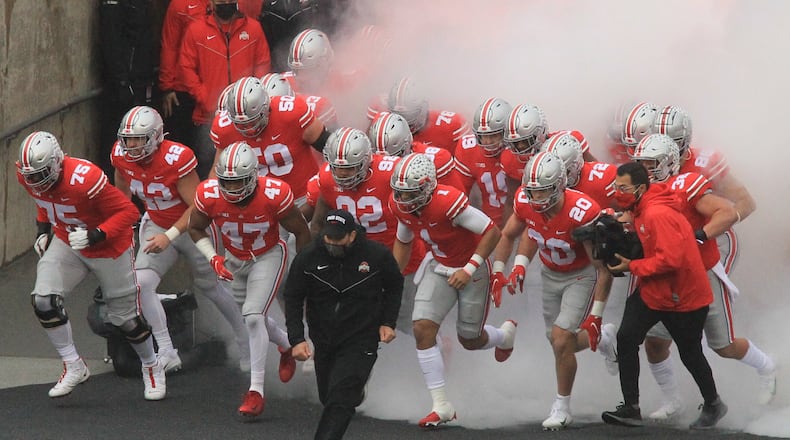That game was cancelled late Friday night because of rising COVID-19 numbers in the OSU program. It’s the second game Ohio State has lost off the schedule. A game Nov. 14 at Maryland was cancelled because of the COVID-19 situation at Maryland.
“I have an extremely heavy heart,” Day said. “Sacrifices have been made by many. There’s been anxiety for months and months of every day getting test results back to make sure the entire program is safe, and to experience it this week, Thanksgiving week, I can’t say it’s been anything other than really hard.”
Ohio State paused team activities on Friday. The status of its next game Dec. 5 at Michigan State is now in question. If No. 4 Ohio State (4-0) doesn’t get to play that game, it will not have enough games at the end of the season to qualify for the Big Ten Championship. Teams must play at least six games. That threshold could be lowered, but Smith said there have been no discussions of that.
Smith said the primary focus for Ohio State right now is on the well being of the players, coaches and staff members.
“It is not about the Big Ten championship game,” Smith said. “It is not about the CFP (College Football Playoff). It’s not about how many games we play. It’s about thing: their health, their safety and making sure we give them a chance to possibly play next week. That’s our focus 100 percent.”
Borchers said the program had not been hit by any positive COVID-19 tests since August until early in the week. It was a small number of cases at first, and then the positive rate increased. It reached a point Friday where Ohio State felt it needed to pause workouts to get the situation under control even though it had not reached the Big Ten threshold where it would have been forced to do so.
Borchers said there are 170 people in Ohio State’s Tier 1 personnel, which includes players, coaches and other staff members. He would not say how many have tested positive but did say no one position group had been affected and that cases were spread among players, coaches and staff members.
Once the first positive tests came in Wednesday, Day said the team started holding virtual meetings and did not do body-to-body contact in practices. They wore masks in walkthroughs and made other adjustments. That did not stop the virus from spreading
“All individuals who have tested positive are doing well,” Borchers said. “No one has required significant medical treatment. We have every intention of providing them what they need. We have every expectation that they will recover and do well and hopefully return not only to athletics but to the other responsibilities they have in their daily lives as quickly as possible.”
The athletes who have tested positive have to self quarantine for 10 days. Then they will have to undergo a cardiac MRI, which is part of the process of returning to play. In the Big Ten, the earliest a player can return after a positive test is 21 days.
It was too early to tell when the team might resume workouts, Smith said, though Day said his team could be ready for Michigan State if it had one good practice Thursday and a walkthrough on Friday.
“We’ll continue to test and see if there are no more positives that occur,” Smith said. “We need to make sure we’re working with our conference office and that they’re comfortable with what we’re doing. A number of athletes won’t compete because they’ll still be in quarantine. We’ll watch our positivity rate and see if we have more or if the young men who have been negative continue to test negative. We need to make sure they’re safe and healthy.”
About the Author

